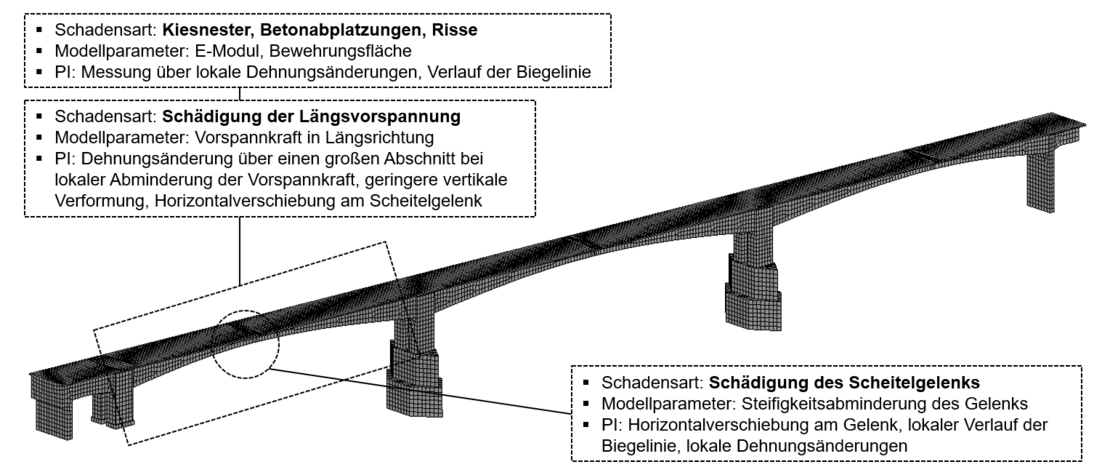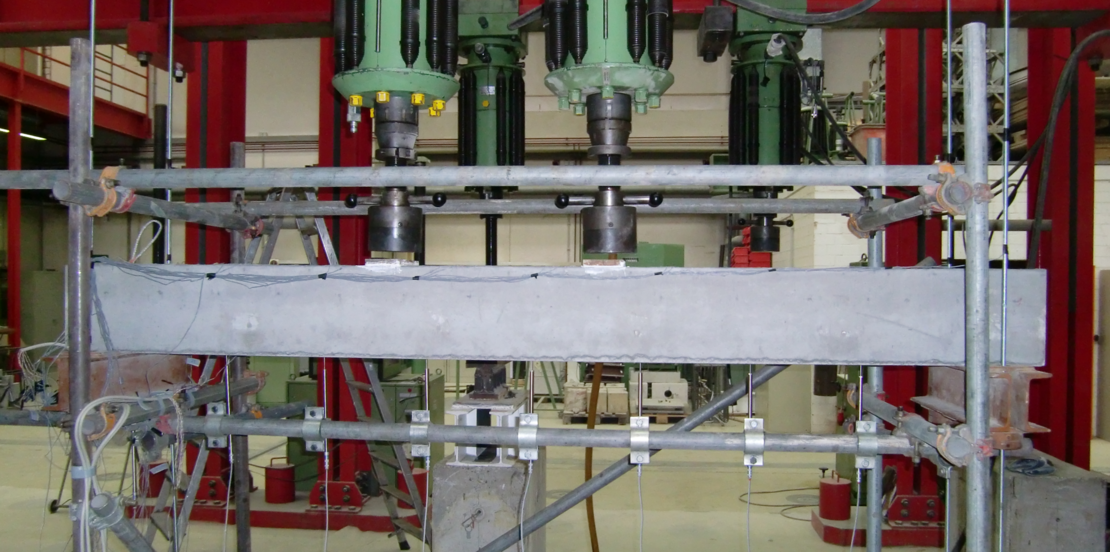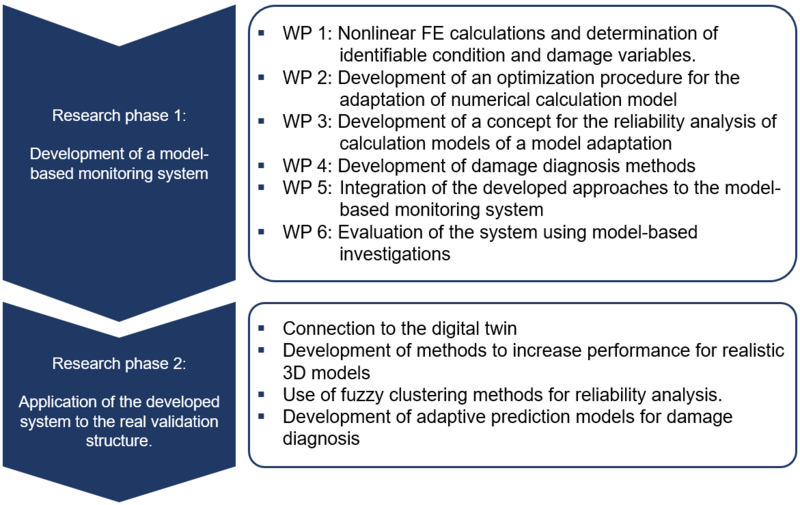Continuous monitoring of structures with model-based damage detection using nonlinear model fitting and artificial intelligence methods
The objective, proper assessment of the condition of structures and the early detection of the type, location and cause of damage represent the key aspects in structural health monitoring. Automated monitoring systems that continuously diagnose the behavior and condition of structures are becoming increasingly important. Non-destructive testing methods based on measurements and computational analysis are particularly useful in structural health monitoring. Currently, however, validated approaches to automated continuous monitoring of global structural health and detection of damage to massive structures face significant challenges.
The incorporation of automated monitoring systems enables objective and continuous recording of the structural condition. Thus, on the one hand, damages can be detected and evaluated promptly, and on the other hand, the aging process of the structure can be documented continuously. In the course of the priority project SPP 100+, the "Nibelungenbrücke" in Worms serves here as a validation structure for the development of an overall approach for the automated condition monitoring of highly stressed solid structures. The condition of the structure is to be described by reliably indicating the location and extent of any damage detected. The approach includes damage detection based on nonlinear model adaptation and artificial intelligence methods.
As part of the nonlinear FE calculations, sensitivity studies are performed to determine the identifiable condition and damage parameters, and the monitoring concept is prepared for the second phase of research. Due to the inverse problem of model adaptation, the uniqueness of solutions will be analyzed and evaluated. For the implementation, different methods of artificial intelligence are to be combined: The optimization task to be solved in the course of nonlinear model adaptation is highly complex.
The considered models can have a different number of degrees of freedom, different loads as well as several damage locations. Based on evolutionary algorithms, an optimization procedure is to be developed and used to find solutions in model adaptation. Since these optimization methods usually do not lead to a unique solution, clustering methods for the description of the obtained solutions will be investigated to increase the reliability. Here, a measurement point is assigned to a numerical computational model whose system component reliably describes the structural condition. Damage diagnosis is then performed by comparing the system states of different measurement time points. The concept of automated damage diagnosis developed in research phase 1 will be applied to the real validation structure in the second research phase.
Project Milestones within the SPP Framework
As part of subproject C05 (project number: 501496870), a concept is being developed for the automated monitoring and damage detection of highly stressed reinforced concrete structures. This concept is based on nonlinear model adaptation and methods of artificial intelligence. A demonstrator structure — the Nibelungen Bridge in Worms — serves to validate the proposed approach.
The developed hybrid algorithm combines Genetic Algorithms (GA) for adapting a finite element (FE) model to the physical structure, a surrogate model for efficient approximation of numerical response and auto-associative artificial neural network encoders (ANN autoencoders) to enhance the reliability of the methodology. The following provides a brief summary of the key milestones and highlights:
Milestone 1: Development of a FE model of the Nibelungen Bridge:
To enable a detailed representation and highly accurate modeling of structural damage, a parameterized FE model of the demonstrator structure was developed, comprising a total of 713620 nodes and 34670 volume elements (Figure 1) [1]. The simulation accounts not only for geometric nonlinearities but also for the nonlinear material behavior of the concrete. To ensure accurate approximation of the structural responses, the response of the undamaged initial model was compared with measurements obtained from the monitoring system installed on the bridge. In an initial validation step, measured thermal influences on the structure were applied to the model as loading conditions. The numerically simulated concrete component temperatures were then compared with the actual measured temperatures in the structure (see Figure 2). The developed FE model and the generated data were made available to the other subprojects within the priority program (SPP).


Milestone 2: Development of a Model-Based Damage Detection Approach
The proposed concept [2,3] integrates GA [4] and ANN autoencoders to adapt the FE model to the actual structure. To validate the approach, various damage scenarios were defined and simulated using the developed methodology. In order to facilitate integration into a live monitoring environment, the computationally intensive FE model was replaced with a surrogate model trained on data from prior sensitivity analyses [5]. Damage detection is achieved by comparing the system parameters identified by the FE model across different measurement time steps. The approach successfully adapted the FE model to various damage scenarios [6], enabling accurate identification of both the time and location of damage occurrence [7].
Milestone 3: Detection of Damage of a Reinforced Concrete Beam
To evaluate the applicability of the approach using real measurement data from structural components, a reinforced concrete beam (Figure 3) was cast and instrumented with sensors. The lower longitudinal reinforcement was subsequently subjected to targeted damage. Using the approach developed in Milestone 2, the load location and intensity, as well as the damage location and severity, were reliably identified.

Ongoing Work in Research Phase 1 (until 09/2025) and Outlook for Research Phase 2:
Further validation of the proposed approach is planned under real-world conditions using the experimental bridge “openLAB” as part of the IDA-KI project, funded by the German Federal Ministry for Digital and Transport (BMDV). Initial validations of the initial model (Figure 4), using measurement data from July 16, 2024, and May 6, 2025, demonstrated a high degree of agreement between measured and simulated structural responses. To support broader use within the priority program (SPP), the model will be further refined and adapted based on additional measurement data before being made available to other subprojects.

References:
[1] Sprenger, B., Schnellenbach-Held, M.: Schadensmodellierung mittels nichtlinearer FE-Simulationen zur Bauwerksüberwachung im Rahmen eines Digitalen Zwillings. In: Oesterle, B., Bögle, A. Weber, W., Striefler, L. (Hrsg.) „Baustatik – Baupraxis 15“. Technische Universität Hamburg, 2024, S. 517-524; https://www.bb15.baustatik-baupraxis.de/Programm/program_presentation.php?id=14
[2] Becks, H., Lippold, L., Winkler, P., Moeller, M., Rohrer, M., Leusmann, T., Anton, D., Sprenger, B., Kähler, P., Rudenko, I., Andrés Arcones, D., Koutsourelakis, P., Unger, J. F., Weiser, M., Petryna, Y., Schnellenbach-Held, M., Lowke, D., Wessels, H., Lenzen, A., Zabel, V., Könke, C., Claßen, M., Hegger, J.: Neuartige Konzepte für die Zustandsüberwachung und -analyse von Brückenbauwerken – Einblicke in das Forschungsvorhaben SPP100. Bauingenieur, Heft 10/2024, S, 327-338; https://doi.org/10.37544/0005-6650-2024-10-63
[3] Steiner, D., Sprenger, B.: Moderne Konzepte im Massivbau – über Potenziale von Methoden der künstlichen Intelligenz. Bautechnik 100 (2023), Heft 6, S. 344 - 350; https://doi.org/10.1002/bate.202300034
[4] Guntermann, L., Sprenger, B.: Entwicklung eines Optimierungsverfahrens zur Strukturidentifikation von Brückenbauwerken. In: Stührenberg, J., Al-Zuriqat, T., Chillón Geck, C. (Hrsg.): „Tagungsband des 35. Forum Bauinformatik 2024“, Technische Universität Hamburg, 2024, S. 497-504; https://doi.org/10.15480/882.13510
[5] Sprenger, B., Schnellenbach-Held, M.: Sensitivity Analysis of Model Parameters in a Nonlinear Model-Updating Approach for Prestressed Concrete Bridges. In: Proceedings of the 11th European Workshop on Structural Health Monitoring (EWSHM 2024), June 2024, Potsdam; https://www.ndt.net/article/ewshm2024/papers/157_manuscript.pdf
[6] Schnellenbach-Held, M.; Sprenger, B.; Otto, M.: A Nonlinear Surrogate-Based Finite Element Model Updating Approach for Prestressed Concrete Bridges. Structural Engineering International, Special Issue, 2025 [accepted]. https://doi.org/10.1080/10168664.2025.2487431
[7] Schnellenbach-Held, M; Sprenger, B.: Automated Damage Detection in a Nonlinear Model Updating Approach for Concrete Bridges. In: Proceedings of the fib Symposium 2025, 2025 [accepted]






